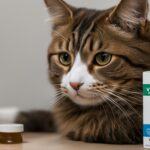Fleas can infest a home even in the absence of pets, and understanding their lifespan and survival in such environments is essential for effective pest control.
Key Takeaways:
- Fleas can enter pet-free homes through various means, such as hitchhiking on other animals or attaching themselves to clothing or furniture.
- Signs of flea infestation in a pet-free home include bug bites, adult flea feces, seeing live fleas, and finding flea eggs in hidden areas.
- Adult fleas can live for up to 12 months without a host, but they require an animal host for their eggs to develop successfully.
- Effective flea control in pet-free homes involves thorough cleaning, the use of insecticides, and seeking professional help from pest control experts.
- Preventive measures for keeping a pet-free home flea-free include maintaining cleanliness and sealing up potential entry points for fleas.
How Do Fleas Enter Pet-Free Homes?
Even without pets, fleas can make their way into homes through different entry points and by attaching themselves to materials or being carried in by other animals. It’s important to understand how fleas can enter a pet-free home to effectively prevent and address infestations. Here are some common ways fleas can find their way into your home:
- Wild animals: Fleas can hitch a ride on wild animals like squirrels, rats, or raccoons that may visit or nest near your home. These animals can bring fleas indoors, allowing them to infest your living space.
- Stray animals: Stray cats or dogs roaming around your neighborhood can carry fleas and inadvertently bring them into your home. These animals may seek shelter or food in your yard or garage, providing an opportunity for fleas to enter.
- Visitors: Fleas can be unknowingly carried into your home by visitors who have pets or have been in contact with animals infested with fleas. The fleas can attach themselves to clothing, bags, or even shoes, and be transported into your living space.
- Used furniture or clothing: Fleas can also be present on used furniture, rugs, or clothing that you bring into your home. It’s important to thoroughly inspect and clean these items before introducing them into your living space.
By being aware of these potential entry points, you can take proactive measures to minimize the risk of fleas infesting your pet-free home. Regularly inspect your home’s exterior for any openings or cracks that may serve as entry points for small animals. Keep your yard clean and free from debris that may attract wildlife. When hosting visitors, encourage them to check their belongings for fleas before entering your home. Additionally, if you purchase used items, make sure to thoroughly clean and treat them to prevent any potential flea infestations.
Remember, preventing a flea infestation in a pet-free home starts with understanding how fleas can enter and taking the necessary precautions to keep them out.
Understanding the Lifecycle of Fleas
To effectively prevent and eliminate flea infestations, it’s essential to understand the lifecycle of fleas. Fleas go through four stages: eggs, larvae, pupae, and adults. While adult fleas are the ones responsible for biting and feeding on hosts, the eggs, larvae, and pupae are vital parts of the infestation cycle. They can be present in your home even without pets.
Flea eggs are tiny and often laid in hidden areas like carpets, bedding, cracks, or crevices. These eggs can lay dormant for weeks or months until they hatch into larvae. The larvae then feed on organic debris, such as flea feces or dead skin cells, before spinning cocoons and entering the pupal stage. Pupae can remain dormant for extended periods, waiting for favorable conditions to emerge as adult fleas. This means that while adult fleas may not survive long without a host, the eggs, larvae, and pupae can persist in the environment.
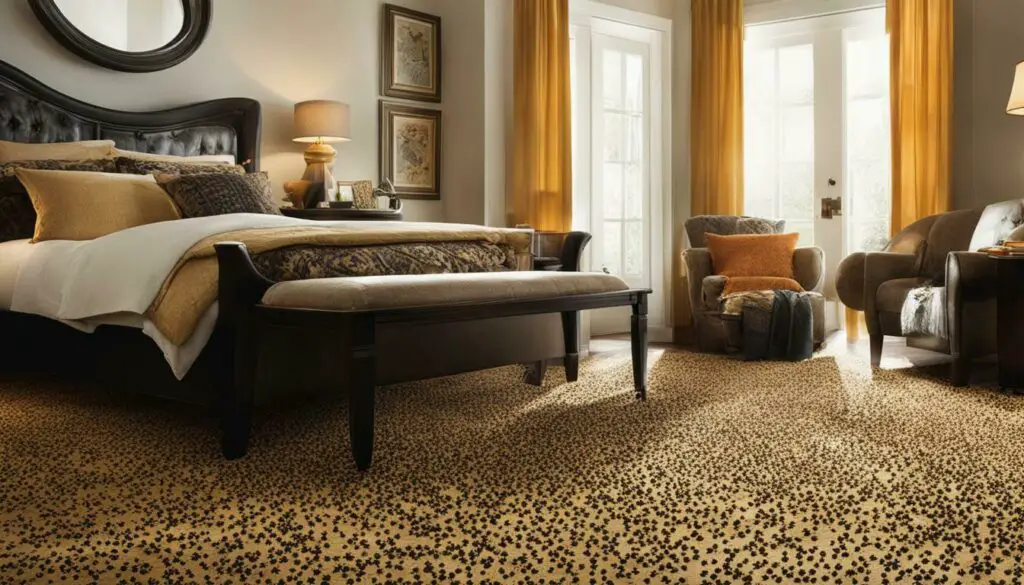
By being aware of the various ways fleas can enter your home and understanding their lifecycle, you can take appropriate actions to prevent and control infestations, ensuring a flea-free environment for you and your family.
Signs of Flea Infestation in a Pet-Free Home
Although there are no pets present, there are still several signs that can indicate the presence of fleas in a pet-free home. One of the most common signs is finding bug bites on your body, especially around the ankles or lower legs. Fleas are known to bite humans, and their bites can cause red, itchy welts. If you notice unusual bug bites that seem to appear out of nowhere, it could be a sign of fleas in your home.
Another telltale sign of a flea infestation is the presence of adult flea feces. Fleas leave behind tiny dark specks that resemble pepper or dirt. These feces, also known as flea dirt, are actually digested blood. To confirm if it is flea dirt, you can do a simple test. Dampen a white paper towel and place the specks on it. If the specks turn reddish-brown, it is likely flea dirt.
Seeing the fleas themselves is a definitive sign of a flea infestation. Fleas are small, agile insects that can quickly jump and move around. They are usually brown in color and have flat bodies, enabling them to navigate through fur or carpet fibers easily. If you spot any jumping insects resembling fleas, it is crucial to take immediate action to eliminate them from your home.
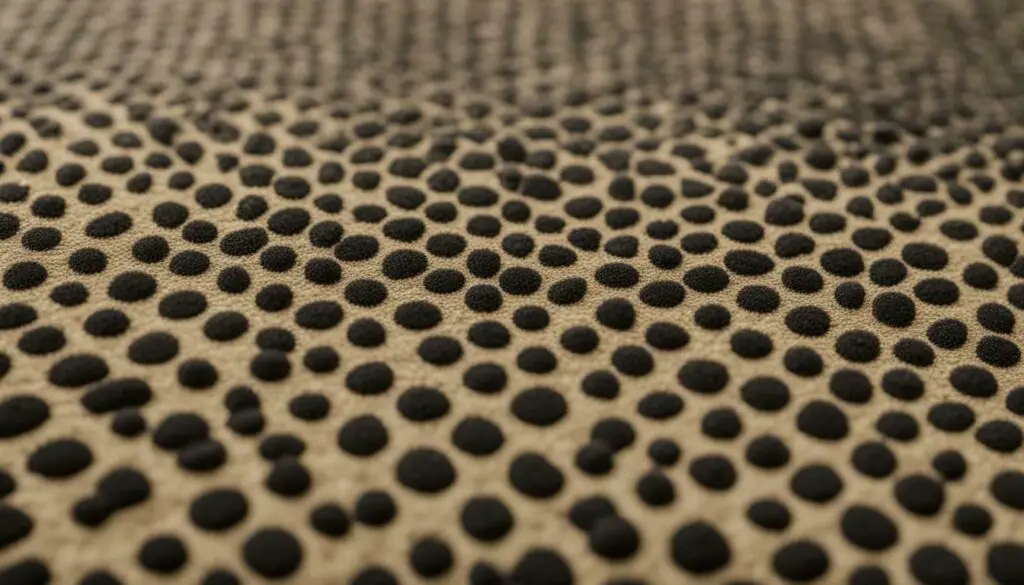
| Signs of Flea Infestation in a Pet-Free Home |
|---|
| Bug bites on the body, particularly around the ankles or lower legs. |
| Presence of dark specks resembling pepper or dirt (flea dirt). |
| Observation of small, brown, jumping insects resembling fleas. |
Finding flea eggs in hidden areas is another indication of a flea infestation. Flea eggs are tiny, white, oval-shaped objects that are typically laid in dark and protected areas, such as carpet fibers, pet bedding, or cracks in flooring. If you discover these eggs, it is a clear sign that fleas have been breeding and reproducing in your home.
Summing Up
In summary, even without pets, homes can still fall victim to flea infestations. Signs of flea infestation in a pet-free home include bug bites on the body, adult flea feces, seeing the fleas themselves, and finding flea eggs in hidden areas. While adult fleas can live for up to 12 months in suitable conditions, they require a host to feed on in order to thrive. To effectively get rid of fleas in a pet-free home, thorough cleaning, the use of insecticides, and professional pest control assistance are recommended. In addition, preventive measures such as maintaining cleanliness and sealing entry points can help keep a pet-free home flea-free. Natural remedies, such as vacuuming, using baking soda and salt, and utilizing herbal repellents, can also aid in controlling fleas. Although adult fleas can survive for a limited time without a host, the eggs, larvae, and pupae can persist longer in the environment. Fleas can enter homes without pets through various means and adapt for a temporary period in pet-free environments.
Lifespan of Adult Fleas Without a Host
Adult fleas can live for up to 12 months in the right conditions, even in the absence of animals to feed on. However, it’s important to note that fleas require a host to thrive and reproduce. Without a suitable host, their survival is limited. Fleas cannot complete their life cycle on human blood alone, and they need animal hosts for their eggs to develop successfully.
While adult fleas can survive for a limited time without a host, the eggs, larvae, and pupae can persist in the environment for longer periods. This means that even in a pet-free home, fleas can still pose a persistent problem. The eggs and larvae can remain dormant in carpets, furniture, and hidden areas until they find a suitable host to feed on.
To effectively control fleas in a pet-free home, it is important to target all stages of the flea life cycle. Thoroughly cleaning the home, including vacuuming carpets and furniture, washing bedding in hot water, and regularly grooming pets, if you have any, are essential steps in preventing and eliminating flea infestations. Using insecticides specifically designed for fleas can also be effective in controlling their population.
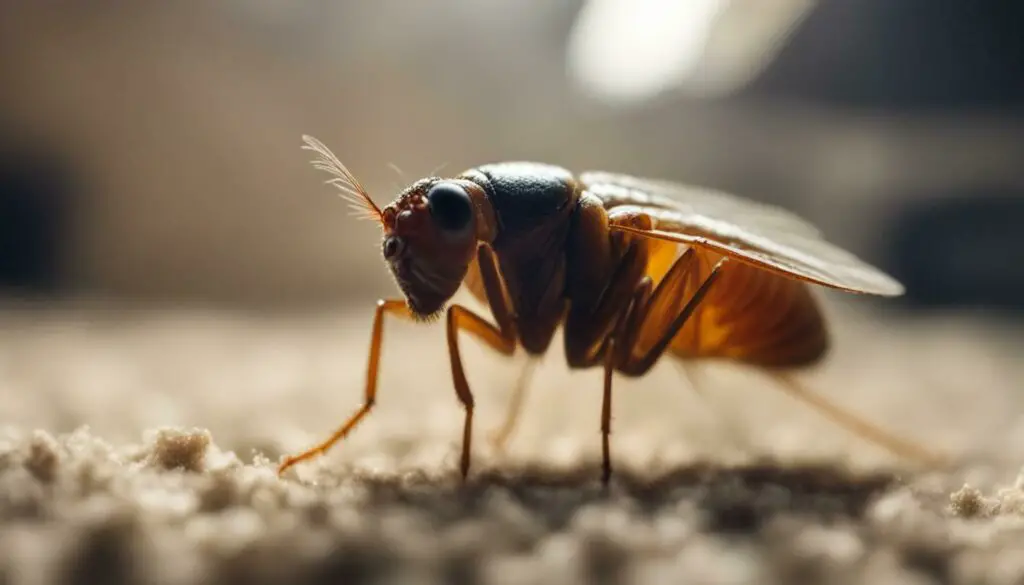
The Importance of Animal Hosts for Flea Development
Fleas cannot complete their life cycle on human blood alone and require animal hosts for their eggs to develop successfully. While adult fleas can survive for a limited time without a host, the eggs, larvae, and pupae can persist for longer periods in the environment. Understanding the role of animal hosts in flea development is crucial in combating infestations in pet-free homes.
Fleas, small wingless insects, rely on blood meals from animals to nourish and reproduce. When a flea feeds on the blood of an animal, it lays eggs that are then deposited in the environment. These eggs hatch into larvae, which later transform into pupae and eventually develop into adult fleas. This life cycle typically takes several weeks, but without an animal host, the cycle may be disrupted.
Table 1 provides a summary of the flea life cycle without pets:
| Stage | Timeframe |
|---|---|
| Egg | 2-12 days |
| Larva | 5-18 days |
| Pupa | 4-14 days |
| Adult | 2 weeks to 12 months |
It is important to note that while adult fleas can survive for up to 12 months in the right conditions, they require a host to feed on to thrive. Without a consistent source of blood, the longevity of adult fleas diminishes. However, the eggs, larvae, and pupae can remain viable in the environment, waiting for the arrival of an animal host.
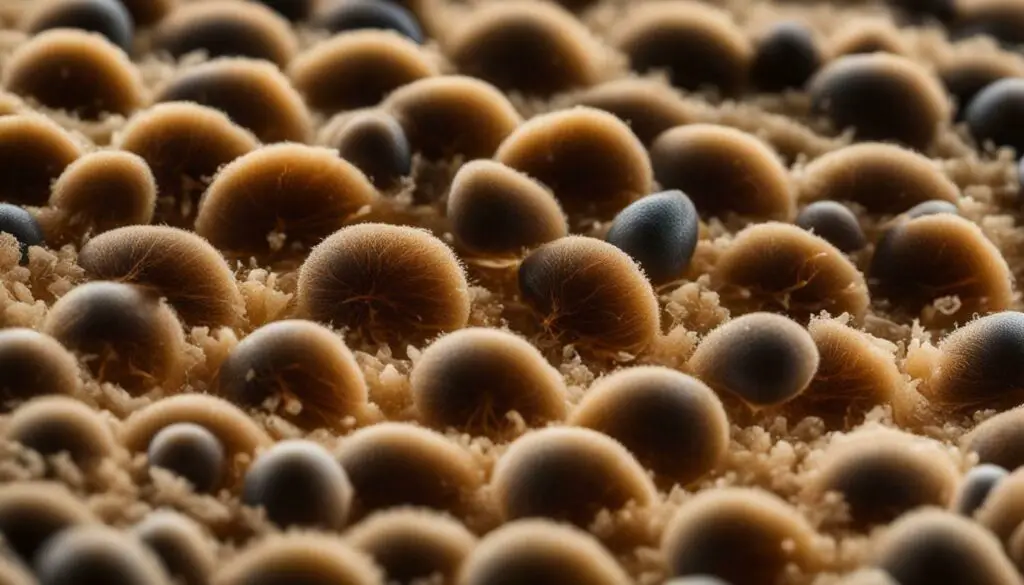
“Fleas cannot complete their life cycle on human blood alone and require animal hosts for their eggs to develop successfully.”
Without animal hosts, fleas may enter pet-free homes through various means. They can hitch a ride on clothing, shoes, or other objects. They can also be carried indoors by other animals, such as rodents or wildlife. Once inside, they can infest carpets, furniture, and bedding, creating a persistent problem.
To effectively control fleas in pet-free homes, it is essential to address both adult fleas and their eggs, larvae, and pupae. Thoroughly cleaning the home, using targeted insecticides, and seeking assistance from pest control experts can help eliminate fleas at all stages of their life cycle.
In addition to chemical treatments, there are natural remedies that can help combat fleas in a pet-free home. Vacuuming regularly, using baking soda and salt as natural insecticides, creating lemon sprays, employing diatomaceous earth, washing bedding in hot water, and using herbal repellents like lavender and eucalyptus can play a role in controlling flea populations.
In summary, while adult fleas can survive for a limited time without a host, they cannot complete their life cycle without animal hosts. Preventive measures, such as keeping the home clean, sealing access points, and implementing natural remedies, can help minimize the risk of flea infestations in pet-free homes. Understanding the importance of animal hosts in flea development is essential for effective flea control.
Getting Rid of Fleas in a Pet-Free Home
Eliminating fleas in a home without pets requires thorough cleaning, targeted treatments, and sometimes professional assistance from pest control experts. While it may seem strange to have a flea infestation without animals, fleas can enter your home through various means and survive in a pet-free environment for a limited time. To effectively get rid of these pesky insects, here are some steps you can take:
- Clean and vacuum regularly: Fleas can hide in carpets, rugs, and upholstery, so it’s essential to vacuum these areas frequently. This will help remove adult fleas, eggs, larvae, and pupae. Remember to empty the vacuum bag or canister immediately to prevent fleas from reinfesting your home.
- Wash bedding and clothing: Fleas can also infest your bedding, clothing, and pet bedding if you have recently had pets or if you have visited a place with fleas. Washing these items in hot water and drying them on high heat can help kill any fleas or eggs that may be present.
- Use insecticides: Insecticides specifically designed for flea control can be effective in eliminating fleas from your home. Follow the instructions carefully and apply the product to areas where fleas are likely to hide, such as behind furniture, along baseboards, and in cracks and crevices. Keep in mind that some insecticides may be harmful to humans and pets, so take proper precautions and consider consulting a professional exterminator.
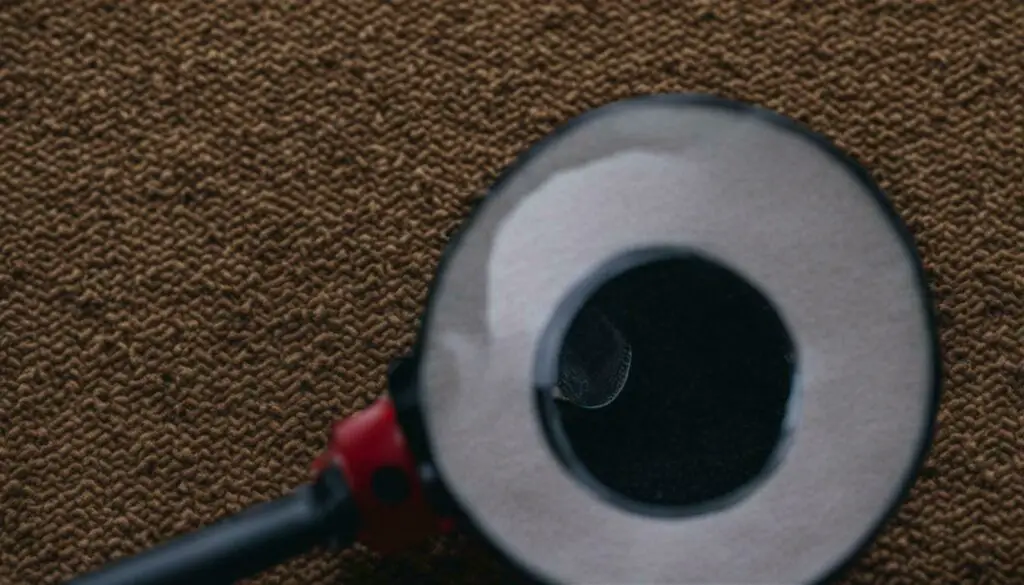
Note: It’s important to remember that fleas can enter your home through other animals, such as rodents or wildlife, so it’s crucial to seal any entry points and take preventive measures to keep them out.
When to Seek Professional Help
If your flea infestation persists despite your best efforts, it may be time to seek professional assistance from pest control experts. They have the knowledge, experience, and specialized treatments to effectively eliminate fleas from your pet-free home. Professional pest control can provide customized solutions based on the severity of the infestation and the specific needs of your home.
Remember, proactive prevention is key to keeping your home flea-free. By implementing regular cleaning routines, sealing entry points, and using natural remedies, you can help minimize the risk of flea infestations in your pet-free home.
Preventive Measures for Pet-Free Homes
To maintain a flea-free home without pets, it is important to implement preventive measures that minimize the chances of flea infestation. While fleas can infest a pet-free environment, taking proactive steps can help keep your home free from these pesky parasites.
Keep the home clean
Regular cleaning is essential to prevent and control fleas in a pet-free home. Vacuuming carpets, rugs, and upholstered furniture can help remove flea eggs, larvae, and pupae from the environment. Pay special attention to hidden areas such as crevices, baseboards, and under furniture. Remember to discard the vacuum bag or empty the canister in an outdoor trash bin to avoid re-infestation.
Seal up access points
Fleas can enter your home through various means, such as being carried in by other animals or attaching themselves to clothing or furniture. To minimize their entry, seal up any access points through which fleas can enter, such as gaps in windows, doors, and screens. Additionally, inspect your home’s exterior for any cracks or openings that need to be repaired.
Use natural remedies
There are several natural remedies that can help combat fleas in a pet-free home. For example, using diatomaceous earth, a fine powder made from fossilized algae, can be sprinkled around areas where fleas are likely to hide. Vacuuming regularly and washing bedding in hot water can also help eliminate fleas and their eggs. Herbal repellents, such as lavender and eucalyptus, can be used to deter fleas from entering your home.
By implementing these preventive measures, you can create a flea-free environment in your pet-free home. However, if you suspect a flea infestation or if preventive measures prove ineffective, it is advisable to seek professional pest control services. Pest control experts can provide customized solutions to effectively eliminate fleas and prevent future infestations.
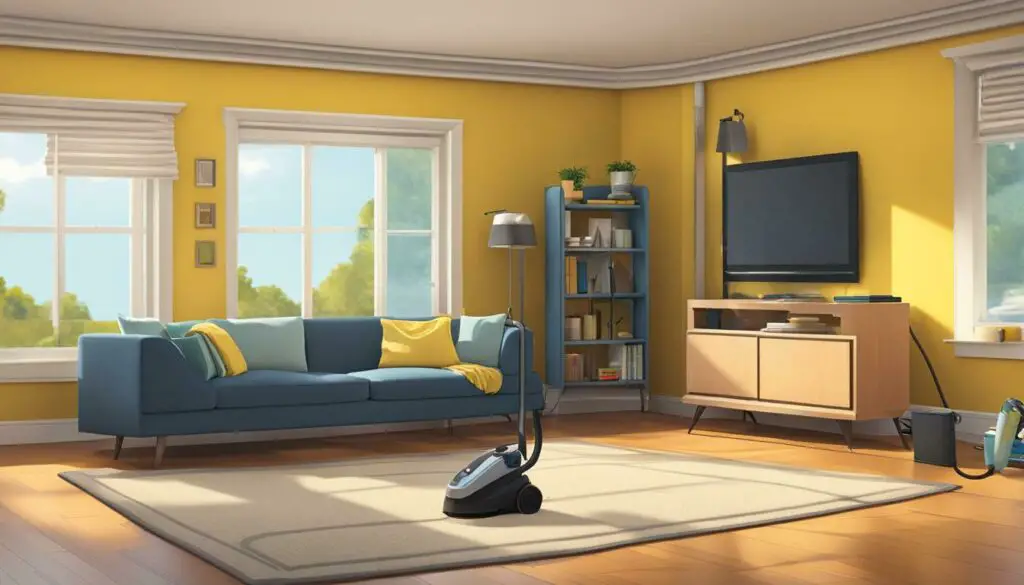
Natural Remedies for Flea Control in Pet-Free Homes
In a pet-free home, there are natural remedies available that can help control fleas without the use of insecticides. These remedies are not only effective in combating fleas but also safer for both humans and the environment. Here are some natural flea control methods to consider:
- Vacuuming: Regular vacuuming not only removes adult fleas but also their eggs and larvae from carpets, rugs, and furniture. Be sure to dispose of the vacuum bag properly to prevent reinfestation.
- Baking Soda and Salt: Sprinkling a mixture of baking soda and salt on carpets and upholstered furniture can help dehydrate and kill fleas. Leave the mixture for a few hours before vacuuming it up.
- Lemon Spray: Lemon has natural flea-repellent properties. To make a lemon spray, steep sliced lemons in boiling water overnight. Transfer the liquid into a spray bottle and mist it around your home, paying attention to areas where fleas are likely to hide.
- Diatomaceous Earth: Diatomaceous earth is a non-toxic powder made from crushed fossilized algae. It acts as a desiccant, dehydrating and killing fleas upon contact. Sprinkle it on carpets, pet bedding, and other flea-infested areas, then vacuum it up after a few hours.
Additionally, washing bedding and pet blankets in hot water can help eliminate fleas and their eggs. Using herbal repellents like lavender or eucalyptus can also deter fleas from infesting your home. These natural remedies, when used together, can create an inhospitable environment for fleas, effectively controlling their population in a pet-free home.

| Remedy | Method |
|---|---|
| Vacuuming | Regularly vacuum carpets, rugs, and furniture to remove fleas, eggs, and larvae. |
| Baking Soda and Salt | Combine baking soda and salt, sprinkle on surfaces, and vacuum after a few hours to dehydrate and kill fleas. |
| Lemon Spray | Steep sliced lemons in boiling water overnight, transfer liquid to a spray bottle, and mist around the house to repel fleas. |
| Diatomaceous Earth | Spread diatomaceous earth on infested areas to dehydrate and eliminate fleas upon contact. |
Adult Flea Survival Without a Host
While adult fleas can survive for a limited time without a host, their ability to reproduce and thrive is significantly compromised in the absence of animal hosts. Without a blood meal, adult fleas can only survive for a few days to a couple of weeks. Their lifespan is dependent on environmental conditions such as temperature, humidity, and availability of food sources.
Adult fleas are highly specialized parasites that have evolved to feed on the blood of animals. They require regular blood meals to reproduce and continue their life cycle. In the absence of an animal host, adult fleas are unable to lay eggs and continue their population growth. Without a suitable host, adult fleas may eventually die off, leading to the decline of the infestation.
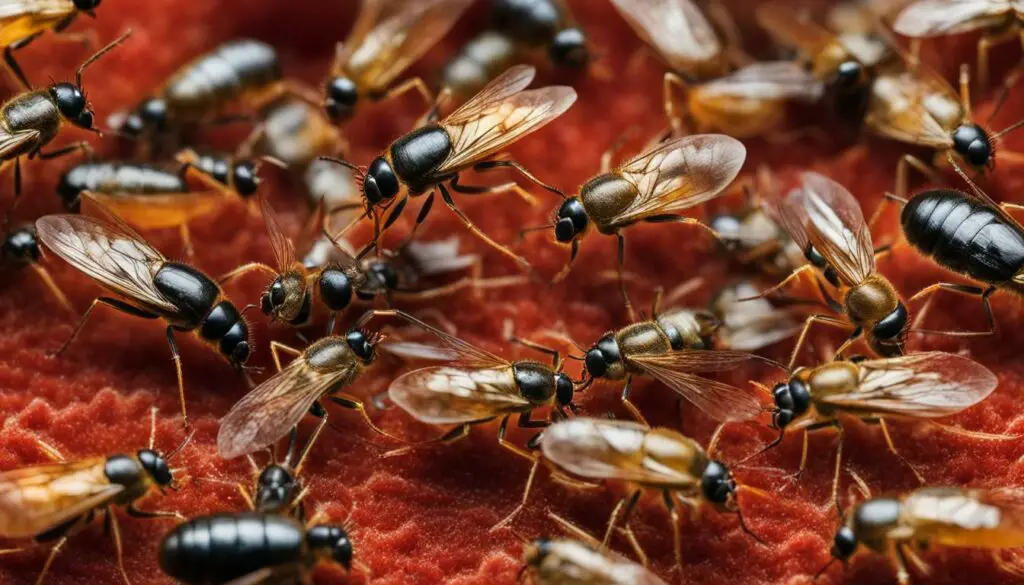
However, it’s important to note that even if adult fleas in a pet-free home die off, the eggs, larvae, and pupae in the environment can still pose a problem. These life stages can persist for longer periods and create a reservoir of fleas that can later infest a home when suitable hosts become available.
To effectively control fleas in a pet-free home, it’s essential to target not only the adult fleas but also their life stages in the environment. Thorough cleaning, vacuuming, and using insecticides can help eliminate adult fleas and disrupt their life cycle. Additionally, contacting professional pest control experts can provide customized solutions for more severe infestations and long-term prevention.
Persistence of Flea Eggs, Larvae, and Pupae in the Environment
In a pet-free home infested with fleas, the eggs, larvae, and pupae can survive and develop over an extended period, creating a persistent problem. While adult fleas may die off without a host, the eggs they lay can remain hidden in carpets, bedding, and furniture until conditions are favorable for hatching. Flea eggs are tiny and can easily slip into crevices, making them difficult to spot and eliminate.
The eggs hatch into larvae within one to ten days and start feeding on organic debris and flea dirt. These tiny worm-like larvae have a strong survival instinct, seeking out dark and hidden areas where they can avoid light and predators. They can remain in this stage for anywhere from five days to several weeks, depending on environmental conditions such as temperature and humidity.
After the larval stage, the pupae develop within a protective cocoon. Pupae can remain dormant for up to several weeks or even months, waiting for the right cues to emerge as adult fleas. This dormant stage, known as the pre-emerged adult, can be particularly challenging to eliminate. Vibrations, warmth, and carbon dioxide from nearby animals can trigger their emergence.
To fully eradicate a flea infestation in a pet-free home, it’s crucial to address all life stages of the flea. Vacuuming regularly, focusing on areas where pets used to frequent, can help remove the eggs, larvae, and pupae from the environment. Washing bedding and fabrics in hot water and drying them on high heat can further eliminate any hidden stages. Additionally, using insecticides that target the different life stages of fleas can help break the cycle and prevent re-infestation.

| Flea Life Stage | Duration in a Pet-Free Home |
|---|---|
| Egg | Up to 10 days to several weeks |
| Larva | 5 days to several weeks |
| Pupa | Several weeks to months |
Various Entry Points for Fleas in Pet-Free Homes
Fleas can enter homes without pets through various means, including hitching a ride on clothing or furniture or being brought in by other animals. These tiny pests are adept at clinging onto fabrics, allowing them to be transported from one place to another unknowingly. For instance, if you’ve been in an environment infested with fleas, they can easily latch onto your clothing or shoes and hitch a ride back to your pet-free home.
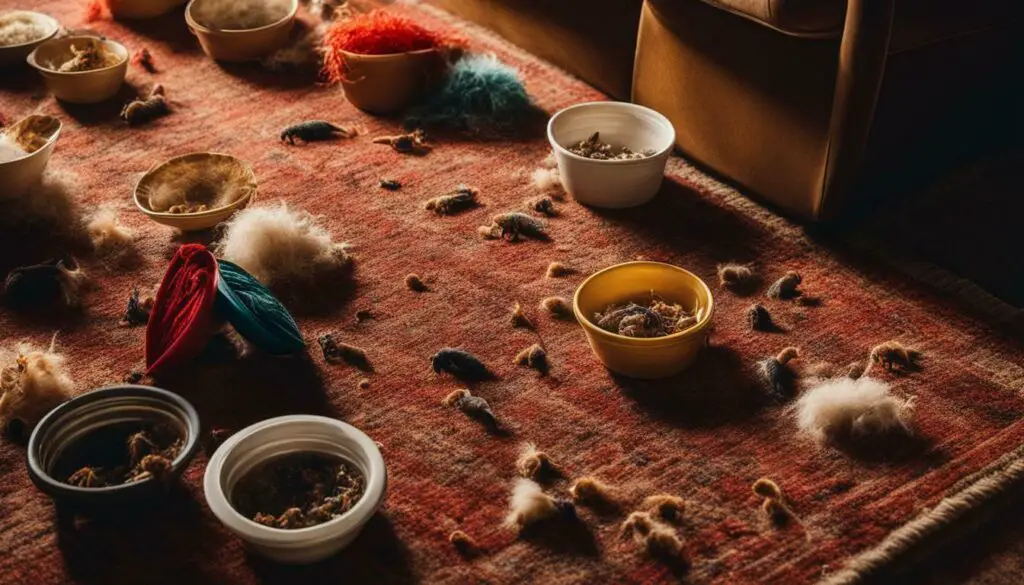
In addition to clothing and shoes, fleas can also attach themselves to furniture and other household items. This means that if you purchase second-hand furniture or borrow items from someone who has a flea problem, there’s a chance that you may inadvertently introduce fleas into your pet-free home. It’s crucial to inspect any items you bring into your home and take preventive measures to ensure they are flea-free.
Furthermore, other animals can unknowingly bring fleas into your pet-free home. Squirrels, rats, mice, or even stray dogs and cats can carry fleas and deposit them in your yard or around your home. Fleas can then find their way indoors through cracks, crevices, or open doors and windows, creating an infestation in your pet-free environment. Regularly inspecting your property for any signs of wildlife activity and taking steps to deter these animals can help minimize the risk of fleas entering your home.
To protect your pet-free home from fleas, it’s important to be vigilant and proactive. Implementing preventive measures like regularly vacuuming and cleaning your home, washing bedding and fabrics in hot water, and sealing up any potential entry points can significantly reduce the likelihood of flea infestations. By addressing these various entry points, you can create a safe and flea-free environment for yourself and your family.
Effective Flea Control in Pet-Free Homes
Implementing an effective flea control plan in a pet-free home involves a combination of cleaning, targeted treatments, and preventive measures to keep the infestation at bay. While it may seem counterintuitive to worry about fleas without pets, these persistent pests can still find their way into our homes through various means. To ensure a flea-free environment, it is essential to take proactive steps in eliminating fleas and preventing their return.
First and foremost, thorough cleaning is crucial in removing fleas and their eggs from your home. Vacuuming all carpets, rugs, and upholstered furniture is a great starting point. Pay special attention to areas where fleas may hide, such as cracks in floors or furniture, and use the crevice attachment to reach these areas.
Additionally, consider using targeted insecticides to treat your home. Choose products specifically designed for flea control and follow the instructions carefully. Apply these treatments to areas where fleas are likely to hide, such as pet bedding, baseboards, and under furniture. Remember to keep pets and children away from treated areas until they are completely dry.
To prevent future infestations, it’s important to take preventive measures. Keep your home clean and tidy, as fleas thrive in cluttered environments. Seal up any access points where fleas could enter, such as gaps under doors or in window frames. Additionally, consider using natural remedies to repel fleas, such as creating lemon sprays or using herbal repellents like lavender and eucalyptus.
By combining regular cleaning, targeted treatments, and preventive measures, you can effectively control fleas in your pet-free home. Remember that persistent flea infestations may require professional pest control assistance. Don’t hesitate to reach out to experts who can provide customized solutions to suit your specific situation.
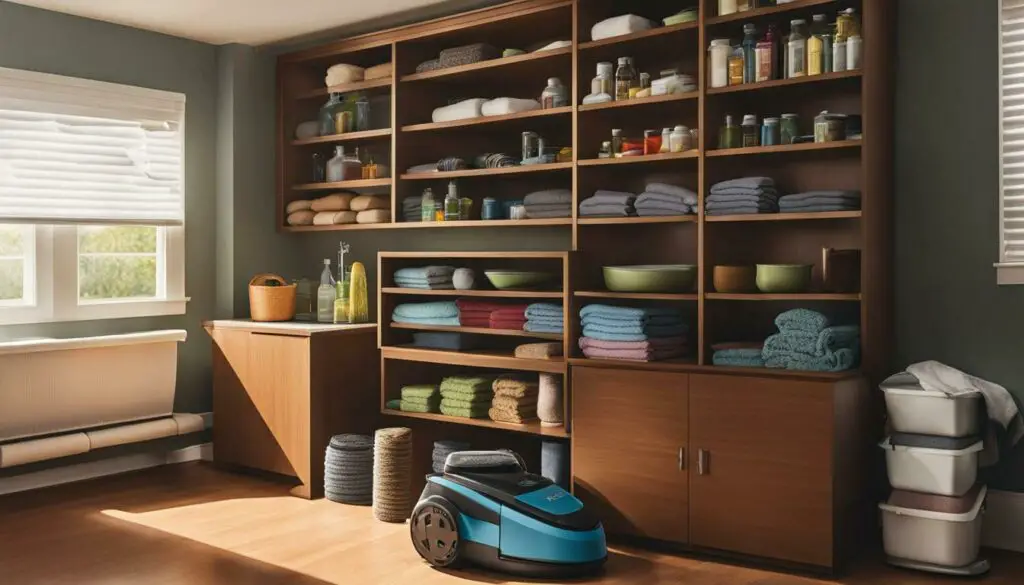
Summary:
- Implement an effective flea control plan in a pet-free home with cleaning, targeted treatments, and preventive measures.
- Clean thoroughly by vacuuming carpets, rugs, and upholstered furniture, paying special attention to hidden areas.
- Use targeted insecticides designed for flea control on pet bedding, baseboards, and under furniture.
- Prevent future infestations by keeping your home clean, sealing access points, and utilizing natural remedies like lemon sprays or herbal repellents.
- Contact professional pest control experts for assistance with persistent flea infestations.
The Role of Professional Pest Control in Pet-Free Homes
When dealing with a flea infestation in a pet-free home, seeking the assistance of professional pest control experts can provide customized solutions and effective results. These experts have the knowledge and experience to identify the extent of the infestation and devise a targeted treatment plan to eliminate fleas from your home.
Professional pest control technicians are trained in the latest flea control methods and have access to specialized tools and products that are not readily available to the general public. They can efficiently and safely apply these treatments to eradicate fleas from every corner of your home, including hidden areas where fleas may be hiding or breeding.
Additionally, professional pest control experts can offer guidance on preventive measures to keep your pet-free home flea-free in the future. They can advise you on practices such as regular cleaning routines, sealing entry points, and using insecticides and repellents to create an inhospitable environment for fleas.
By enlisting the help of professional pest control, you can save time, effort, and frustration in your battle against fleas. Their expertise and tailored solutions will ensure that your home remains flea-free, providing you with peace of mind and a comfortable living environment.
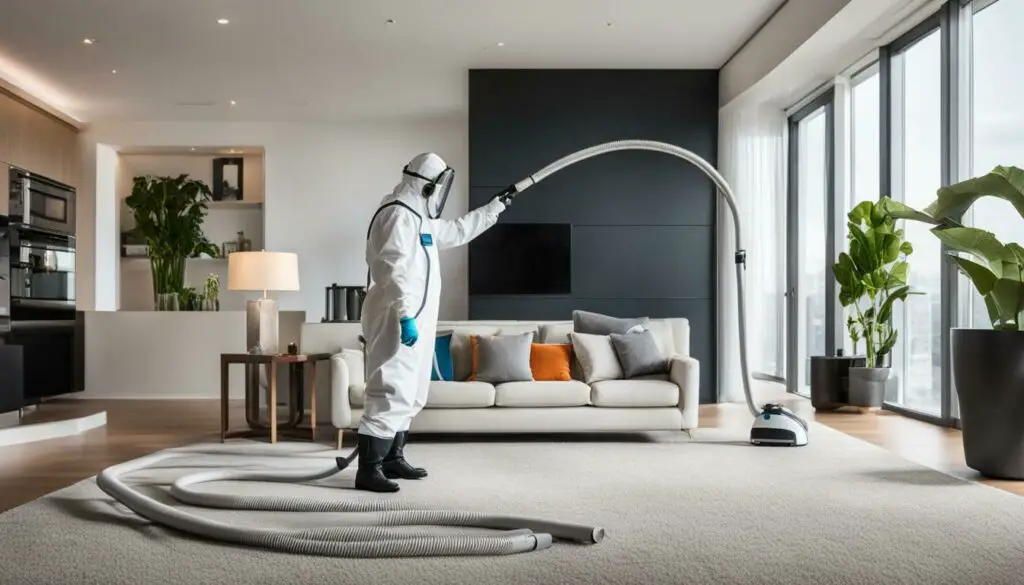
| Pest Control Benefits | Flea Infestation | Professional Expertise |
|---|---|---|
| Customized Solutions | Effective Results | Specialized Tools and Products |
| Targeted Treatment Plans | Extensive Knowledge | Preventive Measures |
| Efficiency and Safety | Peace of Mind | Time and Effort Saving |
“By enlisting the help of professional pest control, you can save time, effort, and frustration in your battle against fleas.”
Expert Solutions for a Flea-Free Home
- Thorough inspection of the home to identify all areas of flea activity.
- Effective treatment application to eliminate fleas at every stage of their life cycle.
- Targeted treatments for hidden areas where fleas may be hiding or breeding.
- Advice on preventive measures, including regular cleaning routines and sealing entry points.
- Use of specialized tools and products to ensure optimal flea control.
Conclusion
Fleas can infest homes without pets, and although they may struggle to thrive without animal hosts, they can still pose a persistent problem that requires attention and action. These resilient pests can enter pet-free homes through various means, such as being carried in by other animals or attaching themselves to materials like clothing or furniture. Therefore, it is essential to be aware of the signs of flea infestation in a pet-free home, including bug bites on the body, adult flea feces, seeing the fleas themselves, and finding flea eggs in hidden areas.
While adult fleas can live for up to 12 months in the right conditions, they require a host to feed on to thrive. Fleas cannot complete their life cycle on human blood alone and need animal hosts for their eggs to develop successfully. To effectively get rid of fleas in a pet-free home, it is crucial to implement thorough cleaning measures, use appropriate insecticides, and consider contacting pest control experts for customized solutions.
Preventive measures play a vital role in keeping a pet-free home free from fleas. This includes maintaining cleanliness, particularly in areas where fleas can hide, as well as sealing up entry points where fleas can enter the home. Additionally, there are natural remedies that can be used to combat fleas, such as vacuuming, using baking soda and salt, creating lemon sprays, using diatomaceous earth, washing bedding in hot water, and utilizing herbal repellents like lavender and eucalyptus.
Although adult fleas may survive for a limited time without a host, it is important to note that flea eggs, larvae, and pupae can persist in the environment for longer periods. Therefore, it is crucial to address the infestation comprehensively to prevent re-infestations. Fleas can enter homes without pets through various means, making it necessary to take proactive measures to block their entry and maintain a flea-free environment.
FAQ
How long can fleas live in a house without pets?
Fleas can survive in a pet-free house for a limited time. While adult fleas can live up to 12 months in the right conditions, they require a host to feed on to thrive. The eggs, larvae, and pupae can persist in the environment for longer periods without a host.
How do fleas enter pet-free homes?
Fleas can enter homes without pets through various means. They can be carried in by other animals, attach themselves to materials like clothing or furniture, or find their way through small cracks and openings in the house.
What are the signs of flea infestation in a pet-free home?
Signs of flea infestation in a pet-free home include bug bites on the body, adult flea feces, seeing the fleas themselves, and finding flea eggs in hidden areas.
How long can adult fleas survive without a host in a pet-free home?
Adult fleas can survive for a limited time without a host in a pet-free home. However, they require a host to feed on to thrive and reproduce.
Do fleas need animal hosts for their eggs to develop successfully?
Yes, fleas need animal hosts for their eggs to develop successfully. While adult fleas can survive without a host for a limited time, the eggs require an animal host to complete their life cycle.
How can I get rid of fleas in a pet-free home?
To get rid of fleas in a pet-free home, it is important to thoroughly clean the home, use insecticides specifically designed for flea control, and consider contacting pest control experts for customized solutions.
What preventive measures can I take for a pet-free home?
Preventive measures for a pet-free home include keeping the home clean, vacuuming regularly, washing bedding in hot water, sealing up access points, and using natural remedies like creating lemon sprays or using herbal repellents.
Are there natural remedies to combat fleas in pet-free homes?
Yes, there are natural remedies that can be used to combat fleas in pet-free homes. These include vacuuming, using baking soda and salt, creating lemon sprays, using diatomaceous earth, washing bedding in hot water, and using herbal repellents like lavender and eucalyptus.
How long can flea eggs, larvae, and pupae persist in the environment without pets?
Flea eggs, larvae, and pupae can persist in the environment for longer periods without pets. While adult fleas may require a host to thrive, the different life stages of fleas can survive in the environment and remain dormant until they find a suitable host.
How do fleas enter pet-free homes without pets?
Fleas can enter pet-free homes without pets through various means. They can be carried in by other animals, attach themselves to materials like clothing or furniture, or find their way through small cracks and openings in the house.






